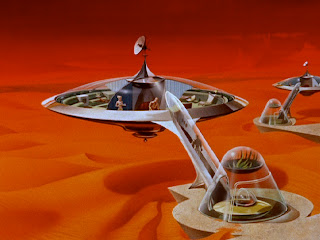Yeah, yeah. Blah, blah, blah. What does this mean?
It means: Simplify.
If you want a lot of stuff to work together, you need a lowest common denometer. You want the most options for angular branching so your forms aren't limited to right angles? Look to your (or your geeky friend's) dice bag:
 The more surfaces, the more options, until you get a sphere.
The more surfaces, the more options, until you get a sphere.
So, a sphere is a very robust, simple form. What about the JOINT? Sure, the sphere could be the joint, if you poke holes into it, and your fill coule be sticks or planes with sticks sticking out of them and you're back to Tinkertoys. Or...
What if the joint is an inherent aspect of the fill?
Congratulations. We've just reinvented the burdock.
Neat things, unless you're trying to get them off the flanks of a squirmy, wooly dog. They inspired the invention of Velcro . So, what if you made burdocks with teeny, tiny hooks? Hooks so small, they wouldn't catch on fabric? What if you made those hooks smart, so they'd release on command?
Congratulations, we just thought up spider feet.
Spider feet are "smart" velcro. When the spider wants to move, unconscious controls make these little micrometer-scale hairs release. It all has to do with Van der Waals forces, which I am in no way qualified to explain.
So! Spider feet, spheres, burdocks- where's this going?
What if the "robot" came down to a matrix of smart velcro? Smart velcro that essentially broke down to "yes" and "no" binary commands? Movement would be progressive and cooperative between two surfaces, a ripple of "yes" commands, meaning grab and hold, propelling the skin (and the form within) forward across another skin/form, while in its wake leaving a trail of "No", meaning release, commands? The possibilites are infinite.
If this was on an electronic scale, could this smart velcro also devote a percntage of its binary transmission to transmitting data? So a structure is also a computer with human interface?
Someone probably already came up with this idea. GMTA?
 The narrower module, left is based on the diameter necessary to fit six cylinders onto a ping-pong ball, allowing regular branching in all three axes, or any obtuse angle from the joint.
The narrower module, left is based on the diameter necessary to fit six cylinders onto a ping-pong ball, allowing regular branching in all three axes, or any obtuse angle from the joint. Above is a layout sample for manufacture. It would be relatively easy to customize these modules for specific angles by moving the relative positions of the joint nests (ie holes).
Above is a layout sample for manufacture. It would be relatively easy to customize these modules for specific angles by moving the relative positions of the joint nests (ie holes).










 The more surfaces, the more options, until you get a sphere.
The more surfaces, the more options, until you get a sphere.






 Mars Colony
Mars Colony